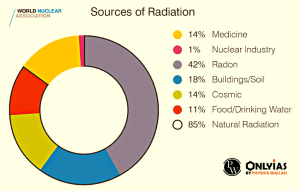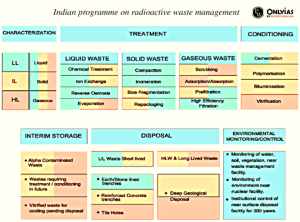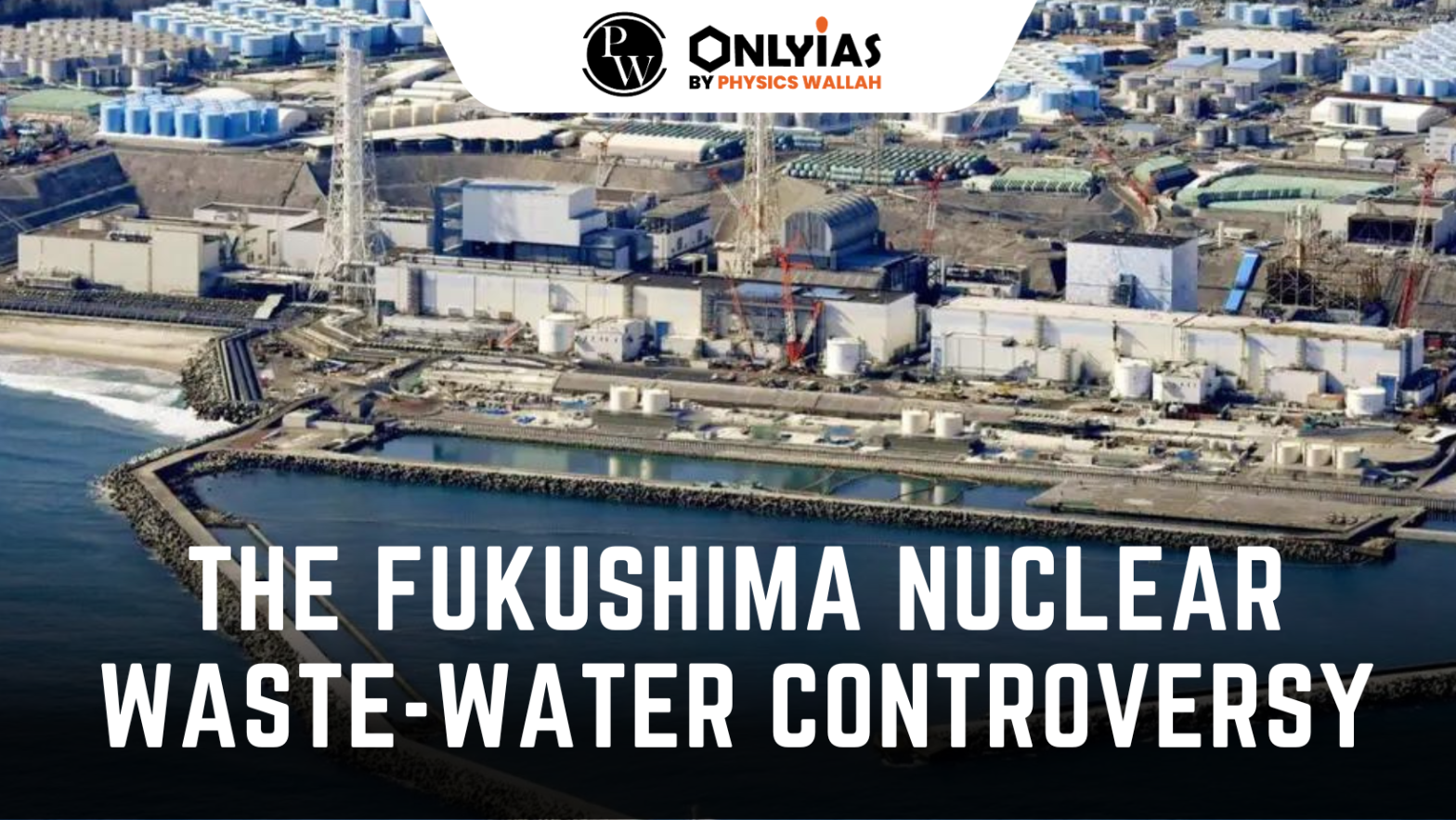Subject: GS3 Disaster Management
Source: The Hindu
Context: Japan began to release contaminated water (Nuclear Waste) from the Fukushima Nuclear Plant into the sea and has been facing an intense backlash from the public and neighboring countries.
Japan’s Controversial Decision: Releasing Fukushima Nuclear waste into the Sea:
- On April 13, 2021, Japan’s government announced plans to release over one million tonnes of contaminated water (Nuclear Waste) from the Fukushima nuclear plant into the sea over the next 30 years.
- The wastewater is a byproduct of the catastrophic 2011 earthquake and tsunami, which disabled the Fukushima Daiichi nuclear power plant, leading to the release of radioactive materials.
Understanding Radioactive Waste: Sources and Classifications of Nuclear Waste
- Radioactive waste/Nuclear Waste is a byproduct of nuclear reactors, fuel processing plants, hospitals and research facilities.
- Radioactive waste is also generated while decommissioning and dismantling nuclear reactors and other nuclear facilities.
- There are two broad classifications of Nuclear Waste
- High-level waste is primarily spent fuel removed from reactors after producing electricity.
- Low-level waste comes from reactor operations and from medical, academic, industrial and other commercial uses of radioactive materials.
Sources of Nuclear Waste / Hazards/ Radioactive Pollution: A learning from Fukushima Disaster
- Natural Sources of Nuclear Waste: Most radiation exposure is from natural sources. These include radioactivity in rocks and soil of the Earth’s crust; radon, a radioactive gas given out by many volcanic rocks and uranium ore, cosmic radiation, etc.
- Cosmic rays from outer space: The quantity depends on altitude and latitude; it is more at higher latitudes and high altitudes.
- Emissions from radioactive materials: In the Earth’s Crust i.e. Rocks, Marine sediments, etc.

- Man-made sources: These sources involve any process that emanates radiation in the environment.
- For Example: During Nuclear waste handling and disposal, radiation gets leaked.
Effects Of Nuclear Radiation on Human Health and Environment: Fukushima Nuclear Waste
- Effects on DNA and mutations: Radiation can break chemical bonds in DNA, causing mutations that can lead to cancer and other health problems. These effects can be instantaneous, prolonged, or delayed, and may even be carried to future generations.
- General physiological effects of Nuclear Waste: Exposure to low doses of radiation (100-250 rads) can cause fatigue, nausea, vomiting, and hair loss. Recovery is possible, but exposure to higher doses can lead to more serious health problems, including death.
- Effects on immunity: Radiation exposure (400-500 rads) can damage the bone marrow and reduce the production of blood cells. This can weaken the immune system and make the body more susceptible to infection.
- High doses of radiation (10,000 rads) can kill cells and damage tissues in vital organs, such as the heart and brain. This can lead to death or serious health problems.
- Occupational diseases cuased by Nuclear Waste: People who work in certain occupations, such as uranium mining, radium watch dial painting, and nuclear power plant operation, are at increased risk of radiation exposure. This exposure can lead to cancer, mutations, and birth defects.
- Effects through biomagnification: Radiation can also affect human health through biomagnification. This occurs when radioactive materials are passed up the food chain and become more concentrated in higher-level predators.
- For example, strontium-90, a radioactive isotope that behaves like calcium, can accumulate in bones and increase the risk of bone cancer.
The effects of nuclear waste on Marine life are variable and can include:
- Genetic mutations, development or reproductive changes, cancer, decreased life-span, and death. Generally, radiation concentrations in marine ecosystems are sublethal due to its low level, but not all organisms are affected equally.
- Gametes and larvae are more susceptible to radiation damage than an adult. Complex species like fish are less tolerant of radiation than organisms like bacteria and algae.
|
Radioactive Waste/Nuclear Waste Management in India: A lesson learnt from Fukushima Disaster
- The general philosophy for radioactive waste management being followed is as below:
- Delay and decay of short-lived radionuclides;
- Concentrate and contain activity as practicable; and
- Dilute and disperse low-level radioactive waste within the authorized limits.
Nuclear Waste Treatment Technology:
- India has adopted a closed fuel cycle option, which involves reprocessing and recycling of the spent fuel. During reprocessing, only about two to three percent of the spent fuel becomes waste and the rest is recycled. In the end, the high-level waste will be placed in geological disposal facilities.
- India is one of the few countries to have mastered the technology of vitrification (developed by BARC). India has the unique distinction of having an operating vitrification plant at Trombay, Tarapur and Kalpakkam.

- Solid waste: Solid waste generated from nuclear power plants after suitable conditioning is disposed of in Near Surface Disposal Facilities (NSDF) located within the exclusion zone boundary of nuclear power plants.
- Liquid waste: Low-level liquid waste generated from nuclear power plants is discharged to the environment after suitable treatment and ensuring compliance with the regulatory limit.
- Gaseous waste: Gaseous waste is treated at the source of generation. The gaseous wastes are discharged to the environment through a 100 m high stack after filtration and dilution with continuous monitoring of radionuclides and compliance with the regulatory limits.
- Regulation in India for Nuclear Waste: The current regulations specify that the radiation dose to the members of the public living near the operating Nuclear Power Plants due to the discharge from the plants shall not exceed the annual limit of 1 mSv (i.e. 1000 micro-Sievert).
- This is in line with the limits set by the International Commission on Radiological Protection (ICRP). Further based on the above limit, AERB (Atomic Energy Regulatory Board) issues ‘authorization’.
The Atomic Energy Regulatory Board: To control Nuclear Waste
- It was constituted on November 15, 1983.
- The regulatory authority of AERB is derived from the rules and notifications promulgated under the Atomic Energy Act of 1962 and the Environment (Protection) Act, of 1986.
- AERB is to ensure the use of ionizing radiation and nuclear energy in India does not cause undue risk to the health of people and the environment.
- AERB issues authorization for disposal of radioactive wastes under Atomic Energy (Safe Disposal of Radioactive Wastes) Rules, 1987.
|
- These authorizations are valid for three years and renewed after a review of the performance of NPPs.
- An independent environmental survey is done by Environment Survey Labs instituted by BARC (Bhabha Atomic Research Center).
Way forward:
- Nuclear waste management at the global level:
- Enhance international cooperation and coordination on nuclear waste management by developing a clear and shared understanding of the risks and challenges posed by nuclear waste.
- Support research and development of new and innovative nuclear waste management technologies. This could help to reduce the risks and costs of nuclear waste management, and to develop more sustainable solutions.
- Establishing Legal Framework:
- This framework should clearly define the roles and responsibilities of different stakeholders, including government agencies, nuclear operators, and the public.
- The legal framework should also provide for independent regulatory oversight of nuclear waste management activities. This will help to ensure that the waste is managed safely and in accordance with the law.
- Concern for Future Generations:
- The management of nuclear waste should also minimize the risk to the health of future generations. This means that the waste should be disposed of in a way that prevents it from contaminating the environment or exposing people to radiation.
- Waste Minimisation, Management Interdependency and Safety of Facilities:
- Generation of radioactive waste shall be kept to the minimum practicable. Interdependency among all steps in radioactive waste generation and management shall be taken into account. The safety of facilities for radioactive waste management shall be assured during their lifetime.
- Wealth to waste generation:
- High-level radioactive liquid waste contains various useful fission products such as 137Cs, 90Sr, 106Ru, etc., which have many industrial as well as medical applications.
- For Example 37Cs can be used as a prominent alternate irradiation source for various applications like blood irradiator, food irradiator, irradiation of sewage sludge, etc.
- Managing and disposing of nuclear waste is a complex and long-term process. However, safety is paramount, requiring rigorous standards, regulations, and oversight, as well as secure emergency measures.
![]() 25 Sep 2023
25 Sep 2023

